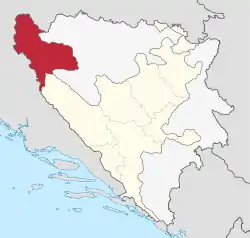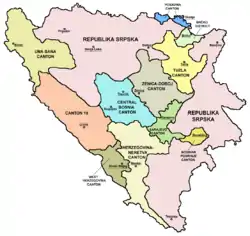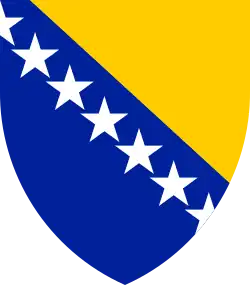Una-Sana Canton | |
|---|---|
 Flag
 Coat of arms
| |
 | |
| Status | Canton of the Federation of Bosnia and Herzegovina |
| Capital and largest city | Bihać |
| Official languages | Bosnian, Croatian |
| Ethnic groups (2013) | 90.02% Bosniaks3.09% Serbs1.85% Croats5.04% others |
| Demonym(s) | Una-Sanian |
| Government | Parliamentary system |
| Nijaz Hušić (SDA) | |
• President of Assembly | Zikrija Duraković (POMAK) |
| Legislature | Assembly of the Una-Sana Canton |
| Canton of the Federation of Bosnia and Herzegovina | |
• Establishment | 12 June 1996 |
| Area | |
• Total | 4,125 km2 (1,593 sq mi) |
| Population | |
• 2013 census | 273,261 |
• Density | 66.24/km2 (171.6/sq mi) |
| GDP (PPP) | 2022 estimate |
• Per capita | $15,622 |
| GDP (nominal) | 2022 estimate |
• Per capita | $6.030 |
| HDI (2019) | 0.760 high |
| Currency | BAM |
| Time zone | UTC+1 (CET) |
| UTC+2 (CEST) | |
| Date format | dd-mm-yyyy |
| Driving side | right |

The Una-Sana Canton[1] (Serbian and Bosnian: Unsko-sanski kanton / Унско-сански кантон;[1] Croatian: Unsko-sanska županija) is one of the ten cantons of the Federation of Bosnia and Herzegovina entity within Bosnia and Herzegovina. It is located in the northwest of the country and has been named after the rivers Una and Sana. The center of the cantonal government is Bihać. The canton is bordered by Republika Srpska from east, Canton 10 from southeast, and Croatia from south, west, and north.
Municipalities
It is divided into municipalities (usually eponymous with towns) of Bihać, Bosanska Krupa, Bosanski Petrovac, Bužim, Cazin, Ključ, Sanski Most and Velika Kladuša.
Political subdivisions
| Municipality | Population | Area (km2) |
|---|---|---|
| Bihać | 56,261 | 900 |
| Bosanska Krupa | 25,545 | 561 |
| Bosanski Petrovac | 7,328 | 709 |
| Bužim | 19,340 | 129 |
| Cazin | 66,149 | 356 |
| Ključ | 16,784 | 358 |
| Sanski Most | 41,475 | 781 |
| Velika Kladuša | 40,419 | 331 |
Demographics
The liberalisation of the labour market in Germany in 2017 resulted in a large wave of emigration from Bosnia and Herzegovina.[2] The Una-Sana Canton is the leader in terms of emigration.[2][3] The Cantonal Ministry of Internal Affairs issued 15,900 certificates of impunity for the purpose of working abroad in 2021.[3][4] For example, in 2017, the Ministry issued around 13,500 of such certificates, in 2018 around 14,800,[5] in 2019 around 12,200[6] and in 2020, the number of such certificates issued was around 9,200.[7] Also, in 2021, about 1,500 children enrolled in the first grades of elementary schools, 2,000 less than 20 years ago.[3]
1991
In the 1991 census, the canton of Una-Sana had 330,479 residents, including:
- 241,511 (73.08%) Muslims
- 67,351 (20.38%) Serbs
- 8,766 (2.653%) Croats
- 12,851 (3.887%) others
2013 Census[8]
| Municipality | Nationality | Total | |||||
|---|---|---|---|---|---|---|---|
| Bosniaks | % | Croats | % | Serbs | % | ||
| Bihać | 49,550 | 88.07 | 3265 | 5.80 | 910 | 1.61 | 56,261 |
| Bosanska Krupa | 23,578 | 92.29 | 66 | 0.25 | 1,260 | 4.93 | 25,545 |
| Bosanski Petrovac | 3,179 | 43.38 | 26 | 0.35 | 3,996 | 54.53 | 7,328 |
| Bužim | 19,207 | 99.31 | 8 | 0.04 | 1 | 0.005 | 19,340 |
| Cazin | 63,463 | 95.93 | 320 | 0.48 | 29 | 0.04 | 66,149 |
| Ključ | 16,130 | 96.33 | 30 | 0.17 | 273 | 1.63 | 16,744 |
| Sanski Most | 38,344 | 92.45 | 722 | 1.74 | 1837 | 4.42 | 41,475 |
| Velika Kladuša | 32,561 | 80.55 | 636 | 1.57 | 146 | 0.36 | 40,419 |
| Canton | 246,012 | 90.02 | 5,073 | 1.85 | 8,452 | 3.09 | 273,261 |
Traffic
Due to the proximity to Croatia and that country's narrow northern outline, various important traffic lines between Zagreb and the Adriatic traverse the Una-Sana canton, such as the railway line Novi Grad – Bihać – Knin. The largest airport of Željava is located near Bihać and is located right between Bosnian and Croatian border.
See also
Footnotes
References
- Fejzović, Emrah (19 January 2022). "Žao mi je zbog porodice i prijatelja, nije lako odreći se državljanstva: Iseljavanje posebno je izraženo u ovom kantonu". Hayat TV. Sarajevo. Retrieved 22 October 2022.
- "Krajišnici odlaze". Federalna televizija. Sarajevo. 12 May 2021. Retrieved 22 October 2022.
- "Iseljavanje: Najveći broj ljudi odlazi iz Bihaća, Bužima, Velike Kladuše i Bosanske Krupe". Inmedia. Sanski Most. 13 February 2019. Retrieved 22 October 2022.
- "USK: Izdato oko 11.400 potvrda o nekažnjavanju u svrhu zapošljavanja van BiH". RadioBK. Bosanska Krupa. Retrieved 22 October 2022.
- "USK ostao bez trećine đaka u deset godina, 400 nastavnika prekobrojno, slijedi ukidanje škola?". Dnevnik.ba. Mostar. 17 September 2021. Retrieved 22 October 2022.
- "Zbog iseljavanja školama prijeti gašenje, nastavnicima upitan posao". Federalna televizija. Sarajevo. 10 September 2022. Retrieved 22 October 2022.
External links
 Media related to Una-Sana Canton at Wikimedia Commons
Media related to Una-Sana Canton at Wikimedia Commons
